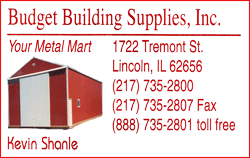 The U.S. Fire Administration recommends that you have your chimney
inspected at least once a year. Tar buildup inside the chimney can
cause the chimney, roof and the whole house to go up in flames.
The U.S. Fire Administration recommends that you have your chimney
inspected at least once a year. Tar buildup inside the chimney can
cause the chimney, roof and the whole house to go up in flames.A
trained chimney sweep, Rodney Kneller, owner of Klein's Chimney
Sweep in Springfield, shed a lot of light on the proper maintenance
that a professional can bring to keeping your home and family safe.
What does a chimney sweep look at during inspection?
Kneller explained that it's a top-to-bottom, inside-and-outside
inspection of the entire system.
While inside looking at the firebox, he checks the integrity of
the metal liner, checking for any seams that may have come apart due
to an extra-hot fire. In masonry fireboxes, he checks for loose
bricks and looks at all the mortar joints, making sure there are no
loose stones or joints that need tuck-pointed. Then, looking up the
flue, he examines for signs of creosote and checks that all the
joints of the sections are properly sealed.

External inspection involves removing the cap with bird screen
and a look-down in a similar evaluation of what might need to be
addressed. Not only does Kneller look for debris and creosote, but
oftentimes there are spider webs. Those just take a quick sweep and
you are good to go for another year.
Maybe you don't have a fireplace yet. In that case, there are a
number of choices in types of fireplaces, and each one has its own
maintenance regimen. There are the traditional wood-burning,
wood-burning converted to gas logs, and gas only. Newer to the
market are the hybrid fireplaces. Hybrid fireplaces provide a gas
source to ignite the kindling, and then the homeowner uses wood to
continue the burning process.
The wood-burning fireplace is evaluated for buildup of creosote.
Creosote is a natural byproduct of combustion. It is a tar-like
substance that collects on the walls of the flue and is very
flammable. Creosote is evaluated on a scale of 1 to 3, with 3 being
the most critical.
It is recommended that pine and the "sappier" woods should not be
burned, because these produce the most creosote, which can result in
chimney fires. In our region, red or white oak is the recommended
hardwood to burn. It has the highest number of BTUs due to its
density and is a cleaner, longer burning wood.
The wood should be seasoned -- that is, cut and split preferably
for one year for optimal performance. Your wood should be stored off
the ground and uncovered. Many homeowners achieve this by laying two
steel posts on top of concrete blocks and driving a couple more
steel stakes at each end to prevent the wood from rolling off.
Wood is oftentimes purchased by the pickup load, but a full
measure is known as a cord. A cord of wood measures 4 by 4 by 8
feet, and a pickup load is usually less than a cord.

One important question to ask when purchasing firewood is if the
price includes stacking it properly upon delivery. Imagine the
homeowner's surprise to come home and find the wood simply dumped in
the driveway.